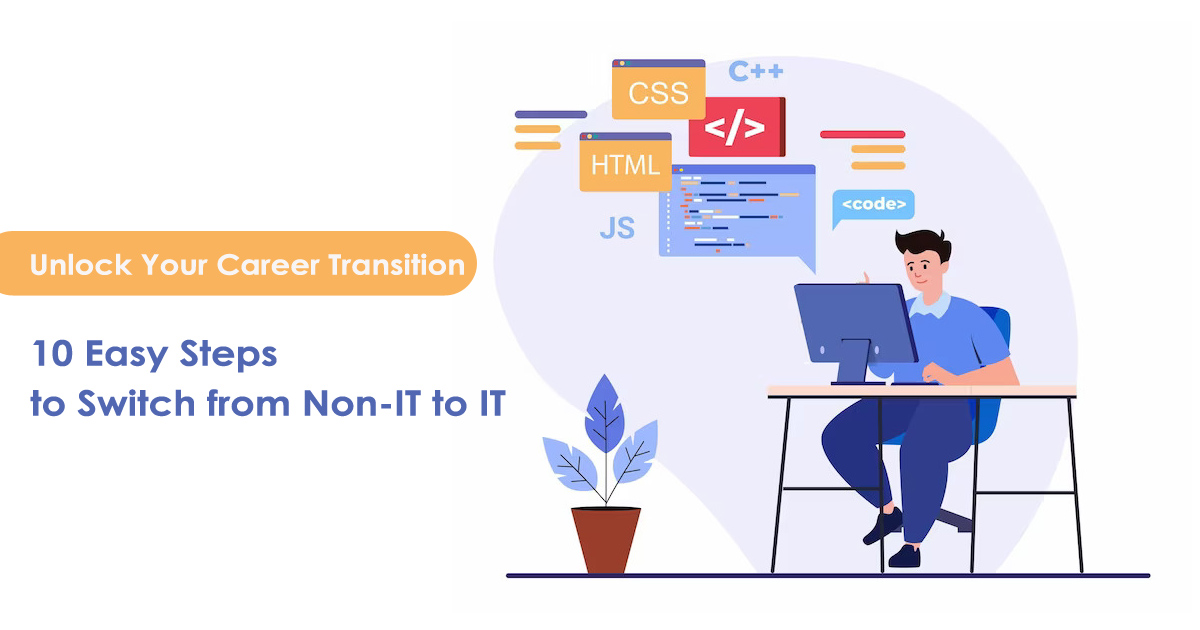Overview
Let’s face it, the tech industry is booming! From groundbreaking advancements in artificial intelligence to the ever-evolving world of web development, there’s a constant buzz of innovation and opportunity. Maybe you’ve found yourself drawn to this exciting field, but the idea of a career change from non-IT to IT feels daunting.
Why Should You Consider It?
The tech industry is booming, and there’s a place for everyone with the right skills and motivation. Even if you don’t have a traditional IT background, you can still make a successful switch.
Here are some reasons why IT might be the perfect fit for your next career move:
- Variety: There are tons of IT specialities to choose from, so you can find a role that aligns with your interests and strengths.
- Skills in Demand: The tech industry is growing rapidly, which means there’s a high demand for skilled IT professionals.
- No Degree Required: While some IT jobs require specific degrees, many focus more on your abilities and experience.
- Lucrative Opportunities: IT careers offer competitive salaries and benefits.
Thinking about making the jump? Here are some questions to ask yourself:
- Why do you want a change? Are you unhappy in your current role, or are you drawn to the problem-solving aspects of IT?
- What are your tech strengths? Do you enjoy troubleshooting gadgets or diving into complex software?
- Are you ready to learn? IT is a constantly evolving field, so a commitment to learning is essential.
If you’re ready to explore a career in IT, there are resources available to help you get started. With the right training and effort, you can make a successful transition and build a fulfilling career in the exciting world of technology.
Ready to Launch Your Tech Career? Here’s Your Roadmap:
1. Find Your IT Niche: Aligning Passion with Skills
The IT field is vast! Web development, machine learning, data science – the options are endless. Take some time to explore different areas and identify one that excites you. This guide includes resources to help you discover the perfect IT fit.
2. Master the Essentials: Building a Strong Foundation
Before diving into specific domains, there are some fundamental concepts everyone in IT should understand. This includes computer fundamentals, operating systems, networking basics, and database management systems (DBMS).
3. Choose Your Programming Language Wisely
There’s no one-size-fits-all answer when it comes to programming languages. C is a great starting point due to its foundational nature, but the best choice ultimately depends on your chosen IT domain.
4. Object-Oriented Programming (OOP): Simplifying Software Development
Understanding OOP concepts like abstraction, encapsulation, inheritance, and polymorphism will make you a more efficient programmer. These principles form the building blocks of well-structured code.
5. Conquer Data Structures and Algorithms (DSA): The Powerhouse of Programming
Data structures provide a way to organize data, while algorithms define the steps to solve problems using that data.
6. Practice Makes Perfect: Sharpening Your Skills
Consistency is key! Once you’ve grasped the basics, dedicate time to daily practice. There are numerous online resources like GeeksforGeeks Practice Portal and Problem of the Day to help you hone your DSA skills.
7. Build Your Portfolio: Projects Make You Stand Out
Theoretical knowledge is valuable, but practical experience is what truly sets you apart. Work on projects related to your chosen IT domain. Start with smaller projects and gradually progress to more complex ones.
8. Craft a Tech-Savvy Resume: Highlighting Your Skills for the ATS
Your resume is your first impression, so make it count! Build a tech-focused resume that showcases the skills you’ve acquired.
9. Aptitude and Reasoning: Preparing for the Interview
Many companies incorporate aptitude and reasoning tests into their interview process. These tests assess your logical thinking and problem-solving abilities.
10. Final learning curve
Transitioning from a non-IT background to IT is a rewarding yet challenging journey that requires dedication, perseverance, and resilience. Embrace the learning curve, celebrate your achievements, and remain resilient in the face of obstacles along the way.
See Also | 10 Best AI Tools for Developers to Boost Coding Efficiency
Bonus Tips for Non-IT Professionals:
- Network on LinkedIn: Build a strong online presence on LinkedIn. Connect with tech professionals, stay updated on industry trends, and showcase your tech skills.
- Explore Freelancing: Freelancing platforms offer a great way to gain practical experience while working remotely on short-term projects. This can help you determine if a particular domain aligns with your interests.
Wrapping-up
By following these 10 easy steps, you can unlock your career transition from non-IT to IT and embark on a fulfilling and prosperous journey in the exciting world of technology. Remember, with determination, continuous learning, and a proactive approach, you have the power to shape your future and thrive in the rapidly evolving IT industry.








